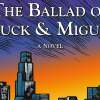The Bowtie Parcel’s Next-Door Neighbors

Published in partnership with Clockshop, "South of Fletcher: Stories from the Bowtie" looks at Los Angeles’s greatest challenges and opportunities: the housing crisis, lack of open space, effects of climate change, and forces of urban development. This unassuming, seemingly abandoned site along the Los Angeles River pulls everything into focus. The future of the Bowtie Parcel, once one of Southern California’s most important railroad yards, is being discussed right now. "South of Fletcher: Stories from the Bowtie" aims to diversify the voices being heard by listening to the people who know the Bowtie — what it was, what it is, and who care about what it will become.

We’ve been calling this place “the Pocket”: a mini-community next to an elevated freeway. Beyond the Pocket is the Bowtie Parcel. There are rows of single-family homes and a few apartment complexes here, on five parallel tree-lined streets.
It’s a quiet, working-class neighborhood. Most of the houses are small and colorful, built by Southern Pacific Lines for their workers, so they’d live close to Taylor Yard.
But by the 1980s and 1990s, this small neighborhood — and the then-abandoned railyard on the other side of the freeway — were not immune to the gangbanging era in L.A., when local criminal gangs like Toonerville, Armenian Power, The Rascals and Frogtown terrorized locals and their rivals with drive-by-shootings, homicides, and burglaries.
“I have endless stories I could tell you about drive-by shootings. It was pretty intense,” Carlos Trujillo said to us when we met. A stocky guy with an easy smile, Carlos grew up in the Pocket and still lives in his childhood home.
Carlos described how one day, a guy walked by his friend’s house and said hello as he and his friend played on the stoop. Then they heard gunshots, and they saw the same guy running, jumping in a van and just driving off. All the parents in the Pocket came out to the street, terrified. Afterwards, some families moved out. But Carlos and his family stuck around: this was home, and they needed to find ways to adapt.

“I think you develop a different sense of life. Because you go out into the world and you’re always looking over your shoulder. Who’s at the door? Who’s not at the door? Who’s walking in?” Carlos said.
In those years, Taylor Yard closed its doors and chain link fences went up to surround it. The abandoned railyard and the residential Pocket next to it picked up an air of seediness, and Carlos, like many of his neighbors at the time, stayed away from the site. Even today, he still associates it with its fenced-in, abandoned history.
He’s heard about the plan to turn the lot into the next urban California State Park. He’s also heard about a proposed housing development on the other side of the freeway that will bring a lot more people — and traffic — to this area. Seemingly overnight, Carlos’ childhood neighborhood has become a hip place to be.
Prices in nearby “hot” neighborhoods have spiked in the past five or six years, while the Pocket remained somewhat affordable, because it’s isolated and next to a freeway. Being neighbors with an abandoned railyard frequented by gangsters had helped keep prices down. But that’s all changing now: Home prices in the neighborhood have risen rapidly in the past year, and news that the Bowtie Parcel will be cleaned up and turned into a state park is making the Pocket a much more attractive investment.

“I would just drive around to see what was available; to see if I could afford anything,” Melissa Roth told us when we met about a year ago.
From that seat in her car she saw a shotgun-style cream-colored house built in 1929, a typical style for this area. She knew about the gangs of the eighties and nineties, but she didn’t seem fazed. She’s been in the Pocket now for six years, and despite the old reputation, she likes it here, especially since she’s only a short walk from the L.A. River and a future state park.
Her next-door neighbor is Carlos Trujillo, whose house is visible if you peek over her cinder block backyard fence. They haven’t yet met one another. Carlos says the newcomers are in denial about the public safety issues that still linger here.

“When you start seeing tagging appear on walls, you understand that, OK, something’s heating up here, something’s going on,” he told us, regarding the gang-related graffiti he’s starting to see all around again.
Many of the Pocket’s long-time residents told us they’ve noticed the graffiti, and in fact, most of them still avoid the Bowtie Parcel. They see the old railyard as a symbol of the blight of Los Angeles, a place where people drink and do drugs, and where gangsters still cause trouble. Their memories are still too strong, and the indecipherable gang-related tags they see bring those feelings back — even as the Pocket keeps changing, welcoming new and unknowing neighbors.
Top Image: A neighborhood street scene | Photo by Bear Guerra
More photos from this project are on view at Occidental’s Weingart Gallery through November 4, presented by Oxy Arts.
The South of Fletcher podcast is live now. New episodes are released bi-weekly on Clockshop and on Apple Podcasts.













